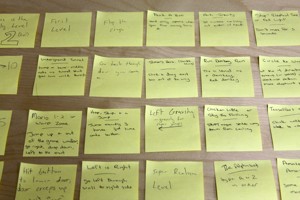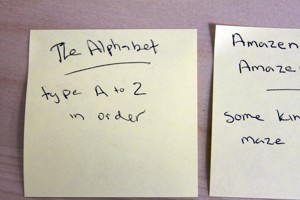This is the Only Level Too: Production Notes

Game development is so much fun sometimes. A lot of times it’s a monster rearing its ugly head, but recently I had an opportunity to make This is the Only Level Too, which quite possibly was the most rewarding game development experience I’ve had of late.

If unfamiliar to the game, its a game about playing the same level over and over again in various forms. In the first level you may have to push a button to open the door, but in the second pass of the level you’ll have to drag the door open with your mouse. Each time the level changes just enough within the level design to create a different experience 30 times over for 30 stages.
I worked on this project with a hardcore Flash gamer Tasselfoot, who is maybe better known for making walkthrough videos for various Flash websites and managing the community of the late Flash Flash Revolution. His position in this project was level design and testing. I’ll give myself enough credit as to say I was fairly involved in level design as well but it was really his initiative and design that rolled this project along. I did the programming and the artwork, as well as porting my own homebrew tile engine to Actionscript 3 finally (its been missing in action for a while).
We met in Irvine, CA one day for a grinding section of brainstorming and level design. Tass came with a general level design (as seen at the top of the post) and together we came up with a good 30 stages.

Post-it Notes are really good for laying out level ideas, and the more and more we looked at each of the levels and progression we got closer and closer to nailing down level design.
It’s a back and forth though. Some level schemes break other level schemes which means levels are incompatible with each other. These have to reach compromise or be forfeited. Luckily we managed to find a median for most level choices. Levels such as the Ice Level (move in one direction until you hit a wall) nearly dictated the entire design (but we just HAD to have it).

One choice we made was to list all the level design on Google Docs. With Google Docs you can share information between multiple individuals quite easily. Since Tass wasn’t onsite for most of the project it was essential that we had a central meeting point to list notes and level progress. It’s amazing how much incentive to finish a few more levels before the end of the day comes out of simple colour coding of spreadsheet squares. I was printing out spreadsheets every day to see what my day was shaping up to be.

Tass was constantly testing and providing feedback while I coded, which is different than what I am used to. Usually it’s a an unaided experience until the last few moments of the project, in which I start getting feedback before features get locked down. It’s a whole different experience when you are constantly working with a game tester.
There was plenty of research too. I ran a poll on the website to see who knew what “Sticky Keys” were just to make sure levels were easily understood. We have an alphabet-based level too, and we went into keyboard layouts to make sure that a good majority of the players could hit the keys for that level (or at least replicate them).
One of the more interesting things are the levels we decided NOT to include. We had planned a Left Gravity level but I decided to nix it towards the end of the project. Some ideas sound really good on paper but once you realize you have to rewrite your entire character jumping and interaction script it becomes a deadly time sink. Another level that was modified was the “Rembrandt” level, which we instead went with a fingerpainting-style art (I thought it looked better). We even had a brown-bag artwork choice for that level that was never implemented.

There are so many tile types in this game. In the first game every tile functioned the same, but in this game we had a lot of features that relied on changing tile types. If you’ve played through the game you’ll probably be able to relate all these tiles to those levels. This was an easy reason why this game took so much longer to produce than its predecessor.

In the end we ended up with a solid 30 stages inside the one level design.
Once again, it was a fun project because its fun level design and programming. It’s like taking a VW Bug and adding more and more random accessories to it until it has everything including an ejector seat. I appreciate Tass’s enthusiasm to help me finish the project and work on it with me and I appreciate the warm reception the project has received.
